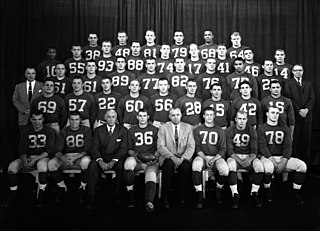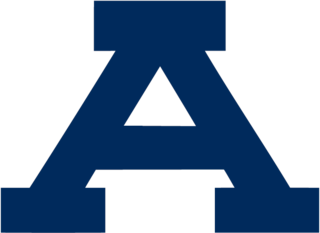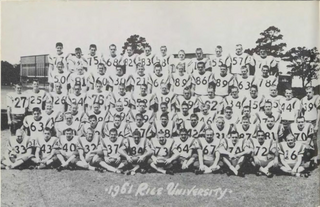The 1961 Florida Gators football team was an American football team that represented the University of Florida as a member of the Southeastern Conference (SEC) during the 1961 college football season. In their second year under head coach Ray Graves, the Gators compiled a 4–5–1 record, finished in sixth place in the SEC, and outscored opponents by a total of 146 to 97.
The 1961 Minnesota Golden Gophers football team was an American football team that represented the University of Minnesota in the 1961 Big Ten Conference football season. In their eighth year under head coach Murray Warmath, the Golden Gophers compiled an 8–2 record, outscored opponents by a total of 140 to 75, and were ranked No. 6 in the final final AP and UPI polls. They defeated UCLA, 21–3, in the 1962 Rose Bowl.

The 1962 Michigan Wolverines football team was an American football team that represented the University of Michigan in the 1962 Big Ten Conference football season. In its fourth year under head coach Bump Elliott, Michigan compiled a 2–7 record, finished in last place in the Big Ten, and were outscored by opponents by a combined total of 214 to 70.

The 1961 Michigan Wolverines football team represented the University of Michigan in the 1961 Big Ten Conference football season. In its third year under head coach Bump Elliott, Michigan compiled a 6–3 record, finished in sixth place in the Big Ten, and outscored opponents by a combined total of 212 to 163.

The 1959 Michigan Wolverines football team was an American football team that represented the University of Michigan in the 1959 Big Ten Conference football season. In its first year under head coach Bump Elliott, Michigan compiled a 4–5 record, finished in seventh place in the Big Ten, and was outscored by a combined total of 161 to 122.

The 1958 Michigan Wolverines football team represented the University of Michigan in the 1958 Big Ten Conference football season. In its 11th and final year under head coach Bennie Oosterbaan, Michigan compiled a 2–6–1 record, finished in eighth place in the Big Ten, and were outscored by opponents by a combined total of 211 to 132 points.

The 1952 Michigan Wolverines football team represented the University of Michigan in the 1952 Big Ten Conference football season. In its fifth year under head coach Bennie Oosterbaan, Michigan compiled a 5–4 record, tied for fourth place in the Big Ten, and outscored opponents by a combined total of 207 to 134. For the second consecutive season, Michigan was not ranked in the final AP Poll; it was ranked at No. 17 in the final Litkenhous Ratings.

The 1951 Michigan Wolverines football team was an American football team that represented the University of Michigan in the 1951 Big Ten Conference football season. In its fourth year under head coach Bennie Oosterbaan, Michigan compiled a 4–5 record, finished in fourth place in the Big Ten, and outscored opponents by a combined total of 135 to 122. For the first time since 1937, Michigan was not ranked in the final AP Poll. It was ranked at No. 29 in the final Litkenhous Ratings.

The 1961 Purdue Boilermakers football team was an American football team that represented Purdue University during the 1961 Big Ten Conference football season. In their sixth year under head coach Jack Mollenkopf, the Boilermakers compiled a 6–3 record, finished fourth in the Big Ten, and outscored opponents by a total of 146 to 87. They were ranked No. 11 in the final UPI poll and No. 12 in the final AP poll.
The 1961 Tampa Spartans football team was an American football team that represented the University of Tampa as an independent during the 1961 college football season. In their 25th season of college football and their 10th season under head coach Marcelino Huerta, the Spartans compiled an 8–1 record and outscored opponents by a total of 188 to 98.
The 1961 Oklahoma Sooners football team was an American football team that represented the University of Oklahoma as a member of the Big Eight Conference during the 1961 college football season. In their 15th year under head coach Bud Wilkinson, the Sooners compiled a 5–5 record, finished in fourth place in the Big 8, and were outscored by a total of 141 to 122. The Sooners lost the first five games of the season before turning things around with five consecutive wins, including a victory over No. 10 Missouri, to finish the season. The 1960 and 1961 seasons were the only non-winning seasons in Wilkinson's 17-year tenure as Oklahoma's head coach.

The 1961 Auburn Tigers football team was an American football team that represented Auburn University as a member of the Southeastern Conference (SEC) during the 1961 college football season. In their 11th year under head coach Ralph "Shug" Jordan, the Tigers compiled a 6–4 record, finished in seventh place in the SEC, and outscored opponents by a total of 174 to 137. It was the Tigers' 70th overall and 28th season as a member of the SEC.

The 1961 Iowa Hawkeyes football team was an American football team that represented the University of Iowa in the 1961 Big Ten Conference football season. In their first year under head coach Jerry Burns, the Hawkeyes compiled a 5–4 record, tied for seventh place in the Big Ten Conference, and outscored opponents by a total of 215 to 162. The team was ranked No. 1 in the AP poll at the start of the season but dropped out of the polls after losing four consecutive games.

The 1961 Indiana Hoosiers football team was an American football team that represented Indiana University in the 1961 Big Ten Conference football season. In their fourth year under head coach Phil Dickens, the Hoosiers compiled a 2–7 record, finished in a tie for last place in the Big Ten Conference, and were outscored by a total of 162 to 96.
The 1961 Duke Blue Devils football team was an American football team that represented Duke University as a member of the Atlantic Coast Conference (ACC) during the 1961 college football season. In their eleventh year under head coach Bill Murray, the Blue Devils compiled a 7–3 record, won the ACC championship, and outscored opponents by a total of 183 to 106. In non-conference games, they defeated Navy and Notre Dame but lost to Georgia Tech and Michigan. They were ranked No. 14 in the final UPI coaches poll and No. 20 in the final AP writers poll.

The 1961 Virginia Cavaliers football team was an American football team that represented the University of Virginia as a member of the Atlantic Coast Conference (ACC) during the 1961 college football season. In their first year under head coach Bill Elias, the Cavaliers compiled a 4–6 record, were outscored by a total of 190 to 123, and finished in eighth place out of eight teams in the ACC. Despite the last place finish, Elias was named ACC Coach of the Year, becoming the second in conference history to win the award in a coach's first year at the school. Elias, who had been the Southern Conference Coach of the Year the previous season at George Washington, snapped Virginia's 28-game losing streak by beating William & Mary in the first game of the season. Their win against South Carolina snapped an 18-game losing streak against ACC foes.

The 1961 Rice Owls football team was an American football team that represented Rice University as a member of the Southwest Conference (SWC) during the 1961 college football season. In their 22nd year under head coach Jess Neely, the Owls compiled a 7–3 record, finished in third place in the SWC, and outscored opponents by a total of 176 to 125. They concluded their season with a 33–7 loss to Kansas in the 1961 Bluebonnet Bowl
The 1961 Harvard Crimson football team was an American football team that represented Harvard University as a member of the Ivy League during the 1961 college football season. In their fifth year under head coach John Yovicsin, the Crimson compiled a 6–3 record and outscored opponents by a total of 160 to 97. They tied with Columbia for the Ivy League championship even though Harvard lost to Columbia by a 26–14 score during the season.
The 1961 Richmond Spiders football team was an American football team that represented the University of Richmond as a member of the Southern Conference (SoCon) during the 1961 college football season. In their eleventh season under head coach Ed Merrick, Richmond compiled a 5–5 record, and were outscored by a total of 194 to 143.
The 1969 Little All-America college football team is composed of college football players from small colleges and universities who were selected by the Associated Press (AP) as the best players at each position. For 1969, the AP selected two teams, each team having separate offensive and defensive platoons.










